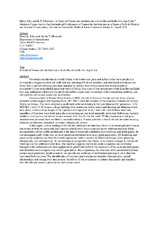| dc.description.abstract | Vernacular architecture is closely linked to both time and place and reflects what most people in a community or region consistently build and use, working with local materials, and traditional techniques and forms. It is a product of design decisions intended to create a built environment that accommodates a community’s own sociocultural needs and ways of living. Our study of the architecture of the Late Bronze/Early Iron Age settlement at Kavousi Vronda (Crete) offers a case study in methods of documentation, analysis, and interpretation of ancient vernacular architecture.
First excavated by Harriet Boyd Hawes in 1900, the site of Kavousi Vronda was the focus of more extensive archaeological investigation from 1987-1992 under the auspices of the American School of Classical Studies at Athens. This work revealed a small rural settlement dating to the Late Minoan IIIC period (ca. 1170-1050 B.C.) with 15-20 houses, a large building with storerooms where communal feasting and drinking rituals took place, a freestanding temple of the “goddess with upraised arms,” and a kiln. All of these structures, regardless of function, were built using the same techniques and local materials: unworked fieldstones, bedrock boulders, mud mortar, and timber beams covered with clay for the flat roofs. While abandonment and post-abandonment processes have resulted in much disturbance, Vronda provides a wealth of data for understanding domestic architecture, household activities, religion and society.
In this paper, a close reading of the Vronda settlement architecture allows us to interrogate how human interaction at both the household and suprahousehold levels were expressed in the built environment. Field documentation of the rubble architecture at the time of excavation included scale drawings and photographs. In our subsequent study of the site, we have employed additional tools (e.g., photogrammetry, 3D modeling, and space syntax analysis) and have borrowed approaches used in modern architectural design, urban planning, ethnography, and anthropology. An archaeological perspective also allows us to observe changes to individual buildings and the settlement over time. Our analysis suggests that the domestic complexes are distributed throughout the settlement and show agglutinative growth that reflects the expansion of the co-residential groups who inhabited each complex over several generations. By comparison, the structures with specialized functions occupy more prominent positions and do not provide any evidence of architectural phasing to show that they were modified over time. The identification of common and exceptional material characteristics, spatial relationships, and change over time reveals the efforts of the community to address their needs and establish their identity and sense of place in the built environment. | en |



